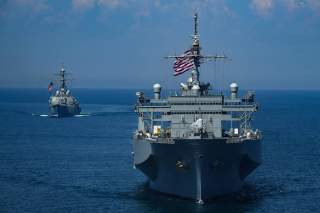Ukraine Wants To Bring Its Navy Into 21st Century (Good Luck)
Stuck between Russia and NATO.
There is also a certain discrepancy in the issue of obtaining missile systems for long-range ground strikes. In the section on “OARS AND SAILS,” this should take place in the third stage, and in the section titled “MAPS AND SEXTANT,” on the second.
The Ukrainian Navy will only be able to fully and effectively respond to the current strategic reality in the Black and Azov Seas at the third stage of development.
Another weakness of the strategy is that, even if it is successfully implemented at the first and second stages, the Ukrainian fleet will still not be able to effectively deal with all threats at sea that are already present in case of all-out war with Russia.
Russia’s occupation and annexation of Crimea in 2014 was not only a loss of Ukrainian territory, but a loss of a central geostrategic position in the Black Sea. Russia systematically deploys weapons systems on this territory that make it possible to influence the situation on the sea and in the air above the sea. These include anti-ship missile complexes BAL (at least four launchers of eight missiles each) and Bastion (at least four launches with two missiles each), two regiments of S-400 air defense systems (not less than 128 missiles for one-shot volley), and Russia’s 27th mixed air division (including not less than eight Su-30SM fighters, which can carry X-35 anti-ship missiles). Such forces allow Russia to control the air and surface space over a large part of the Black and Azov Seas. After all, these capabilities in the occupied Crimea pose a greater threat that Russian Black Sea fleet and Coast Guard Forces themselves.
The Ukrainian Navy will be able to effectively address this problem only after acquiring the capabilities for precision ground strikes. The Ukrainian naval command understands that, by concentrating only on military actions at sea, it is thereby leaving Russia with a powerful trump card—the ability to influence the situation at sea through land-based anti-ship missile systems, air defense systems and aviation. However, getting capabilities for precision ground strikes is a matter of time and considerable resources.
Meanwhile, some supporters of the mosquito fleet, who say that acquiring four-five missile boats of the “Lan”-class will solve all the problems at sea are misleading people. These boats will be only able to attack surface maritime targets with anti-ship missiles. But the same task can be performed by the land and air variants of anti-ship complexes based on the Neptune missile, which would also be less vulnerable than missile boats. Thus, mosquito fleet itself cannot solve the problems created by Russian anti-access area-denial (A2/AD) forces stationed in Crimea, which can greatly (negatively for Ukraine) affect the situation at seas.
This, in turn, raises doubts as to how successful Ukraine’s navy will be in its ability to control certain parts of the surface, underwater and air spaces in the exclusive economic zone (EEZ) in 2030 as stated in strategy. Until the Ukrainian Navy acquires the capability to strike ground targets in militarized Crimea there will be the approximately zero possibility of establishing control over parts of the EEZ. Actions in this part of the sea will continue to be associated with significant risks—especially for surface platforms.
Do we need to allow the Navy to develop a separate potential for precision long-range ground strikes?
As mentioned above without adequate capacity, it will be difficult for Ukraine to counter the Russian military capabilities of militarized Crimea, which in turn have the potential to seriously affect the situation at Black and Azov seas. But there is open question on whether Ukraine’s fleet should be allowed to create separate capabilities for precision long-range ground strikes.
Indeed, navies of major powers are trying to maximize their operational latitude in order to operate separately from other types of armed forces—as seen in the U.S. Navy having Tomahawk cruise missiles for ground attacks. However, it is doubtful that Ukraine's political leadership should give consent to the Navy’s aim to proceed in the same way, given the country’s limited resources. Geography and relatively small distances make it possible to strike Crimea from the Kherson region and not necessary from sea. For this purpose, the Armed Forces will be able to use the potential of missile systems “Vilkha” in the future and the operational-tactical missile complex “Grim/Thunder-2,” which might cover the entire Crimean Peninsula.
This approach will require the Navy to learn to coordinate its actions with other branches of armed forces in the process of conducting operations. However, this will be a significant step in Ukraine’s ability to conduct joint operations, allowing Ukraine to save its relatively limited resources.
Therefore, the Ukrainian Navy’s development strategy through 2035 presents various advantages and weaknesses. Incompatibilities in individual sections can be corrected quite quickly, but more serious problems will persist. The question remains whether Ukraine will be able to finance the second and third stages of its Navy’s developmental strategy to the fullest extent. Similarly, the Ukrainian Navy will be able to effectively counter all present threats from the Russian Federation at sea only in the third stage after he development of the capability for precision long-range land strike. Thus, it is doubtful that the Ukrainian government should agree with the Navy’s desire to have a separate capacity from other branches of armed forces to perform this task.
Mykola Bielieskov is the deputy director of the Institute of World Policy in Kyiv, Ukraine. This first appeared last year.
Image: Reuters.

